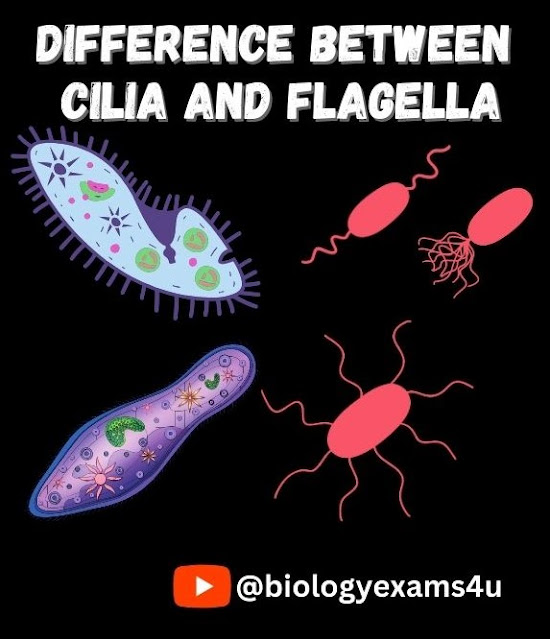Cilia and flagella are hair-like, microscopic, filamentous protoplasmic processes. Both cilia and flagella are involved in cell motility.

The body of a Paramecium (unicellular protozoan) is fully covered by a few thousands of cilia. Cells present in the upper respiratory tract of mammals’ bear cilia to expel particulate matter present in inhaled air. A mammalian spermatozoan contains single flagellum, while a unicellular Chlamydomonas, a green alga has two flagella. Even a prokaryotic bacterium has flagella but it differs structurally from a eukaryotic flagella.
Although cilia and flagella are morphologically and physiologically identical, but it can be differentiated on the basis of their size, number and function.
|
Cilia |
Flagella |
|
Smaller in size up to 5–10 μm |
Larger in size up to 150 μm |
|
Occurs throughout the
surface of a cell |
Occurs at one end of the cell |
|
Numerous in number |
One or two in number |
|
Moves in a co-ordinated
rhythm and show sweeping or perpendicular stroke motion |
Moves independently and
show undulatory movement or whiplash movement |
|
It is found in: • Protozoans
(class—Ciliata) • Ciliated epithelium
of metazoan • Larvae of
Platyhelminthes, ribbon worms, Annelids, Mollusca and Echinodermata |
It is found in: • Plants (algae and
gamete cells) • Sponges (Choanocyte
cells) • Spermatozoa of
Metazoa • Protozoans (class—Flagellata) |
Cilia are smaller in size and present in large number in a ciliated cell whereas, flagella are longer in size and typically vary from one or two in number.
Cilia and flagella are fibrillar and made up of microtubules. Their fundamental structure is same. Both arise from a centriole-like structure known as basal body. Electron microscopic view shows that they are bounded by a unit membrane (90 Å thickness ) which is continuous with plasma membrane. They have a core known as axoneme in the matrix containing nine peripheral and two central microtubules. Such an arrangement is referred as 9+2 array. Central fibrils are enclosed by a sheath.
Learn more: Functions of Cilia and Flagella
Post a Comment
We Love to hear from U :) Leave us a Comment to improve this site
Thanks for Visiting.....